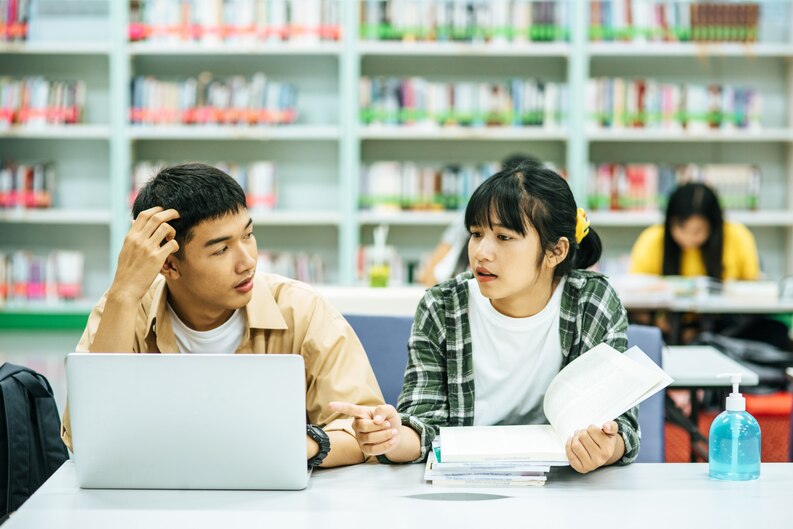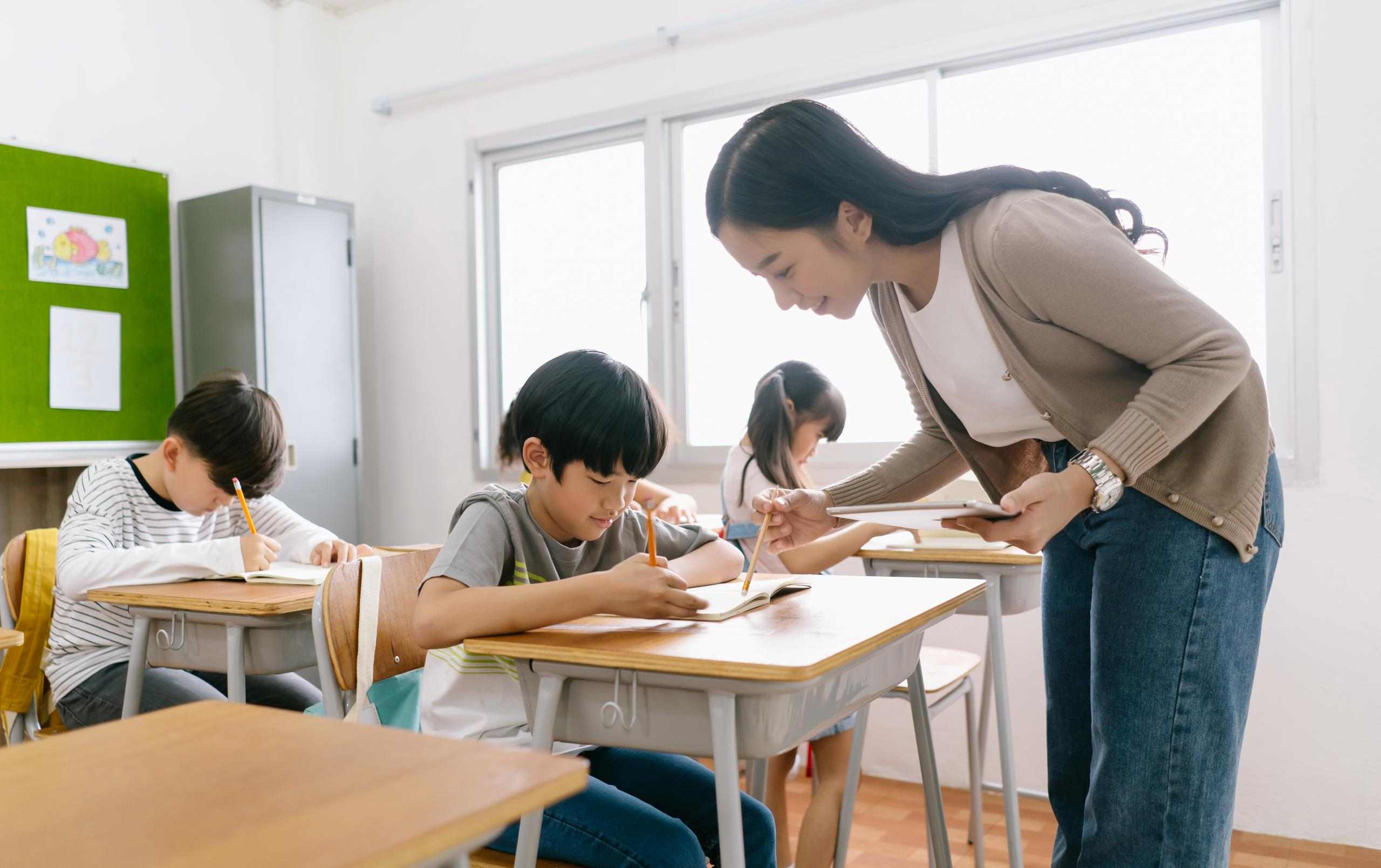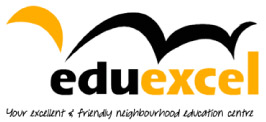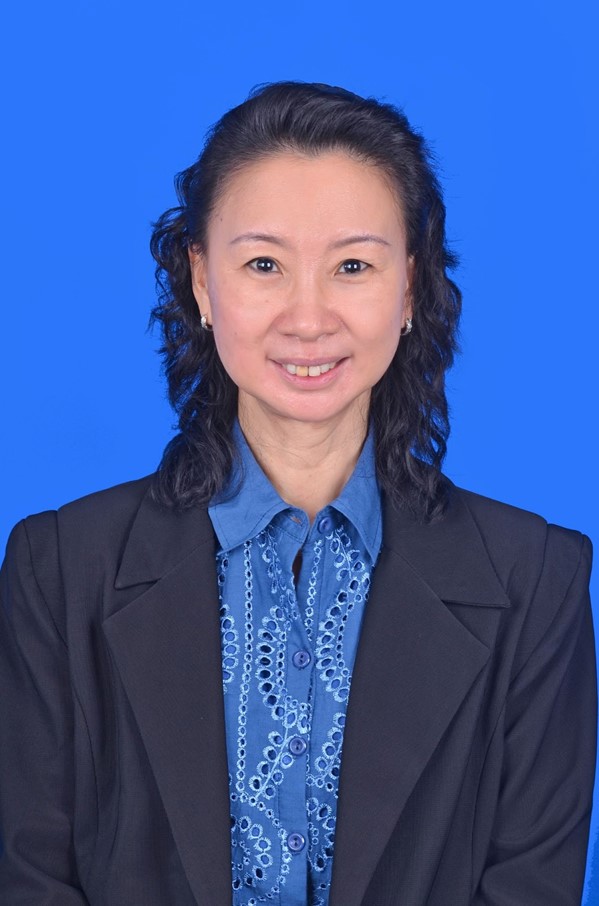National School Curriculum Tuition (SK, SJKC, SMK, SMJK)

At Eduexcel Academy, we fully embrace the transformative power of technology in modern education. Acknowledging that students have varied learning preferences, we have adopted a flexible approach to our classes. Students now have the option to participate either online or in person, providing them with the convenience and accessibility of digital learning, whilst retaining the traditional benefits of face-to-face instruction. Whether they are joining from the comfort of their homes or attending in person, we ensure that all students receive the same high standard of education.
We are also acutely aware of the challenges that arise when students feel overlooked or neglected in larger class settings. Studies have shown that a lack of individual attention can lead to diminished engagement and poorer academic performance. To address this, our academy specialises in small group or individual learning sessions. This structure enables our teachers to focus on each student’s unique needs, ensuring that no one is left behind and that every student is given the opportunity to excel. By creating a more personalised learning environment, we can better support students in achieving their academic goals.
Our commitment to education spans all levels, from primary school to the higher level at SPM. We offer an extensive range of subjects to cater to the diverse academic needs of our students. Whether a student is just beginning their educational journey or preparing for critical examinations, we provide a broad selection of subjects. These include core subjects such as English and Malay (Bahasa Melayu), History (Sejarah), and Geography (Geografi) alongside specialised subjects like Principles of Accounting, Science, Biology, Chemistry, Physics, Mathematics, and Additional Mathematics. For those interested in the humanities and social sciences, we offer classes in Business (Perniagaan) , and Economics, as well as many other subjects tailored to meet individual learning objectives.
At Eduexcel Academy, our mission is to deliver a well-rounded education that not only emphasises academic excellence but also nurtures a supportive and inclusive learning environment. We believe that every student has the potential to succeed, and we are committed to helping them realise their full potential, no matter their level or subject of study.
Read more about Malaysian National Academic Curriculum
Primary Education
Primary education in Malaysia begins at age seven and lasts for six years, referred to as Year (Tahun) 1 to 6 (also known as Standard (Darjah) 1 to 6). Year 1 to Year 3 are classified as Level One (Tahap Satu) while Year 4 to Year 6 are considered as Level Two (Tahap Dua). Students are promoted to the next year regardless of their academic performance.
From 1996 until 2000, the Penilaian Tahap Satu (PTS) or the Level One Evaluation was administered to Year 3 students. Excellence in this test allowed students to skip Year 4 and attend Year 5 instead. However, the test was removed from 2001 onwards due to concerns that parents and teachers were unduly pressuring students to pass the exam.
Before progressing to secondary education, Year 6 pupils sit for the Primary School Achievement Test (Ujian Pencapaian Sekolah Rendah, UPSR). The subjects tested are Malay comprehension, Malay writing, English comprehension, English writing, Science and Mathematics. In addition to the six subjects, Chinese comprehension and written Chinese are compulsory in Chinese schools, while Tamil comprehension and written Tamil are compulsory in Tamil schools.
School types and medium of instruction
Public primary schools are divided into two categories based on the medium of instruction:
- Malay-medium National Schools (Sekolah Kebangsaan, SK)
- non-Malay-medium National-type Schools (Sekolah Jenis Kebangsaan, SJK), also known as “vernacular schools”
- National-type School (Chinese) (Sekolah Jenis Kebangsaan (Cina), SJK(C)), Mandarin-medium and simplified Chinese writing
- National-type School (Tamil) (Sekolah Jenis Kebangsaan (Tamil), SJK (T)), Tamil-medium
Malay and English are compulsory subjects in all schools. All schools use the same syllabus for non-language subjects regardless of the medium of instruction. The teaching of the Chinese language is compulsory in SJK(C), and Tamil language is compulsory in SJK(T). Additionally, a National School must provide the teaching of Chinese or Tamil language, as well as indigenous languages wherever practical, if the parents of at least 15 pupils in the school request that the particular language be taught.
In January 2003, a mixed medium of instruction was introduced so that students would learn Science and Mathematics in English. Due to pressure from the Chinese community, SJK(C) teach Science and Mathematics in both English and Chinese. However, the government reversed the policy of teaching Science and Mathematics in English in July 2009, and previous languages of instruction will be reintroduced in stages from 2012.
By degree of government funding, National Schools are government-owned and operated, while National-type Schools are mostly government-aided, though some are government-owned. In government-aided National-type Schools, the government is responsible for funding the school operations, teachers’ training and salary, and setting the school curriculum, while the school buildings and assets belong to the local ethnic communities, which elect a board of directors for each school to safeguard the school properties. Between 1995 and 2000, the Seventh Malaysia Plan allocation for primary education development allocated 96.5% to National Schools which had 75% of total enrolment. Chinese National-type Schools (21% enrolment) received 2.4% of the allocation while Tamil National-type Schools (3.6% enrolment) received 1% of the allocation.[citation needed]
Previously, there were also other types of National-type Schools. The English National-type Schools were assimilated to become National Schools as a result of decolonisation. Others, such as those for the Punjabi language were closed due to the dwindling number of students. The role of promoting the Punjabi language and culture is currently fulfilled by Gurdwaras (Sikh temples) based organisations.
The division of public education at the primary level into National and National-type Schools has been criticised for allegedly creating racial polarisation at an early age.[23] To address the problem, attempts have been made to establish Sekolah Wawasan (“vision schools”). Under the concept, three schools (typically one SK, one SJK(C) and one SJK(T)) would share the same school compound and facilities while maintaining different school administrations, ostensibly to encourage closer interaction. However, this was met with objections from most of the Chinese and Indian communities as they believe this will restrict the use of their mother tongue in schools.
Secondary Education
Public secondary education in Malaysia is provided by National Secondary Schools (Sekolah Menengah Kebangsaan, SMK). National Secondary Schools use Malay as the main medium of instruction because Malay language is the National language of Malaysia while English is a compulsory subject in all schools. Since 2003, Science and Mathematics had been taught in English, however in 2009 the government decided to revert to use Malay starting in year 2012.[24]
As in primary schools, a National Secondary School must provide teaching of Chinese and Tamil languages, as well as indigenous languages wherever practical, on request of parents of at least 15 pupils in the school. In addition, foreign languages such as Arabic or Japanese may be taught at certain schools.
Secondary education lasts for five years, referred to as Form (Tingkatan) 1 to 5. Form 1 to Form 3 are known as Lower Secondary (Menengah Rendah), while Form 4 and 5 are known as Upper Secondary (Menengah Atas). Most students who had completed primary education are admitted to Form 1. Students from national-type primary schools have the additional requirement to obtain a minimum D grade for the Malay subjects in UPSR, failing which they will have to attend a year-long transition class, commonly called “Remove” (Kelas/Tingkatan Peralihan), before proceeding to Form 1. As in primary schools, students are promoted to the next year regardless of their academic performance.
Co-curricular activities are compulsory at the secondary level, where all students must participate in at least 2 activities for most states, and 3 activities for the Sarawak region. There are many co-curricular activities offered at the secondary level, varying at each school and each student is judged based in these areas. Competitions and performances are regularly organised. Co-curricular activities are often categorised under the following: Uniformed Groups, Performing Arts, Clubs & Societies, Sports & Games. Student may also participate in more than 2 co-curricular activities.
At the end of Form 3, the Pentaksiran Tingkatan 3 (PT3) or Form Three Assessment is taken by students. Based on PT3 results and choice, they will be given three streams to choose from, (1)Academic Stream (Science/Art), Technical and Vocational Stream, and Religious Stream. The Academic stream is generally more desirable. Students are allowed to shift to the Arts stream from the Science stream, but rarely vice versa. In 2013, the government announced to replace Lower Certificate of Education (LCE) evaluation system or “Penilaian Menengah Rendah” with another assessment system which is the Form 3 Assessment or Pentaksiran Tingkatan 3 (PT3).
At the end of Form 5, students are required to take the Sijil Pelajaran Malaysia (SPM) or Malaysian Certificate of Education examination, before graduating from secondary school. The SPM was based on the old British School Certificate examination before it became General Certificate of Education O Levels examination, which became the GCSE (General Certificate of Secondary Education). As of 2006, students are given a GCE ‘O’ Level grade for their English paper in addition to the normal English SPM paper. (Previously, this was reported on result slips as a separate result labelled 1119, which meant students received two grades for their English papers.) This separate grade is given based on the marks of the essay-writing component of the English paper. The essay section of the English paper is remarked under the supervision of officials from the British O Levels examination. Although not part of their final certificates, the O Level grade is included on their results slip.
Shortly after the release of the 2005 SPM results in March 2006, the Education Ministry announced it was considering reforming the SPM system due to what was perceived as over-emphasis on As. Local educators appeared responsive to the suggestion, with one professor at the University of Malaya deploring university students who could not write letters, debate, or understand footnoting. He complained that “They don’t understand what I am saying. I cannot communicate with them.” He claimed that “Before 1957 (the year of independence), school heroes were not those with 8As or 9As, they were the great debaters, those good in drama, in sport, and those leading the Scouts and Girl Guides.” A former Education Director-General, Murad Mohd Noor, agreed, saying that “The rat race now begins at Standard 6 with the UPSR, with the competition resulting in parents forcing their children to attend private tuition.” He also expressed dismay at the prevalence of students taking 15 or 16 subjects for the SPM, calling it “unnecessary”.
A subset of the public secondary schools are known as National-type Secondary Schools (Sekolah Menengah Jenis Kebangsaan, SMJK). At Malayan Independence (1957), it was decided that secondary education would be provided in Malay-medium National Secondary Schools and English-medium National-type Secondary Schools. Fee paying, English-medium schools owned and administered by missionaries/religious bodies were offered government aid provided that they adopted the national curriculum. Secondary schools using other languages as medium of instruction, most of them Chinese schools, were offered government aid on the condition that they convert into English-medium schools. In the 1970s, as the government began to abolish English-medium education in public schools, all National-type Secondary School were gradually converted into Malay-medium schools. The term “National-type Secondary School” is not present in the Education Act of 1996, which blurred the distinction between SMK and SMJK. However, Chinese educational groups are unwelcoming of the new development and continue to push for the distinction to be made between the 78 formerly Chinese-medium schools and other secondary schools. The schools continue to have “SMJK” on the school signboards and boards of directors continue to manage the school properties, as opposed to schools that are directly managed by the government. Most former Chinese-medium SMJK continue to have a majority Chinese student and teacher population, usually only accept students from Chinese-medium primary schools, have Chinese language as a compulsory subject and have bilingual (Malay and Chinese) school announcements.
Other types of government or government-aided secondary schools include Religious Secondary School (Sekolah Menengah Agama), Technical Schools (Sekolah Menengah Teknik), Fully Residential Schools and MARA Junior Science College (Maktab Rendah Sains MARA).
Within the national public school system are a few magnet type/charter public high schools. Admissions are very selective, reserved for students who demonstrate outstanding academic achievement and potential at the elementary level, Year/Standard 1 through 6. These schools are either full-time day or boarding schools (‘asrama penuh’). Examples of these schools are Sekolah Tuanku Abdul Rahman, Royal Military College (Malaysia) and Penang Free School.
Residential schools or Sekolah Berasrama Penuh are also known as Science Schools. These schools used to cater mainly for Malay elites but have since expanded as schools for nurturing Malays who are outstanding academically or those displaying talents in sports and leadership. The schools are modelled after British Boarding School.
Eduexcel After-school Student Care (EASC) programme

At Eduexcel Academy, we are committed to supporting students on their academic journey through comprehensive and personalised services. Our one-to-one homework guidance ensures that each student receives the individual attention required to fully understand challenging concepts and excel in their studies. This is complemented by our tuition classes and study revision sessions, which are carefully tailored to meet the unique learning needs of every student enrolled in our student care programme. We take a holistic approach, treating every student as a valued member of our family, fostering a close-knit, supportive environment where no one is left behind. We are dedicated to providing the encouragement and resources needed for students to thrive academically and personally.
Beyond academic guidance, we offer optional services designed to make life easier for both students and parents. Our lunch programme offers a variety of dishes, catering to different preferences to ensure students are well-nourished and ready to focus on their studies. Additionally, we provide bath facilities for those who wish to freshen up after a day of learning, enhancing their comfort during their time with us.
At Eduexcel Academy, we recognise that academic success is not solely about hard work; students also need opportunities to relax and recharge. To support this, we organise annual outdoor trips, allowing students to explore new environments, build friendships, and create lasting memories. We also offer holiday skills workshops that focus on both fun and learning, enabling students to develop new talents and skills outside of the traditional classroom setting. These activities provide a welcome break from the pressures of schoolwork, helping students to relieve stress whilst enjoying enriching, memorable experiences.
At the core of Eduexcel Academy is a commitment to nurturing both the academic and personal growth of every student, ensuring they are fully supported in all aspects of their development.
IGCSE Academic Support and Enhancement Classes

At Eduexcel Academy, we warmly welcome students from all backgrounds and educational qualifications. In keeping with our inclusive ethos, we offer specialised classes for students from private schools, homeschools, and international schools following the IGCSE curriculum. We believe that every student, regardless of their educational journey, deserves access to high-quality learning.
To ensure students can attend tuition from anywhere at any time, we provide both in-person and online sessions. This flexibility allows students to benefit from quality education, whether they prefer the traditional classroom experience or the convenience of online learning.
We focus on small group classes and personalised one-to-one sessions. This enables us to tailor our teaching to the specific needs of each student, ensuring they receive the attention and support required to excel.
Our broad range of subjects encompasses both core and specialised areas. These include English as a First Language, English as a Second Language, Mathematics, Additional Mathematics, Physics, Chemistry, and Biology. For those interested in the social sciences, we offer History and Geography. Additionally, we provide instruction in foreign languages, including Malay and Chinese, ensuring a well-rounded and diverse educational experience.
International Academic Curriculum Enhancement Courses
Physical & online session
Individual session / Private class / Premium Tuition Centre (Small group class)
International curriculum (International Primary Schools, IGCSE, O-level, A-level/Pre-U)








